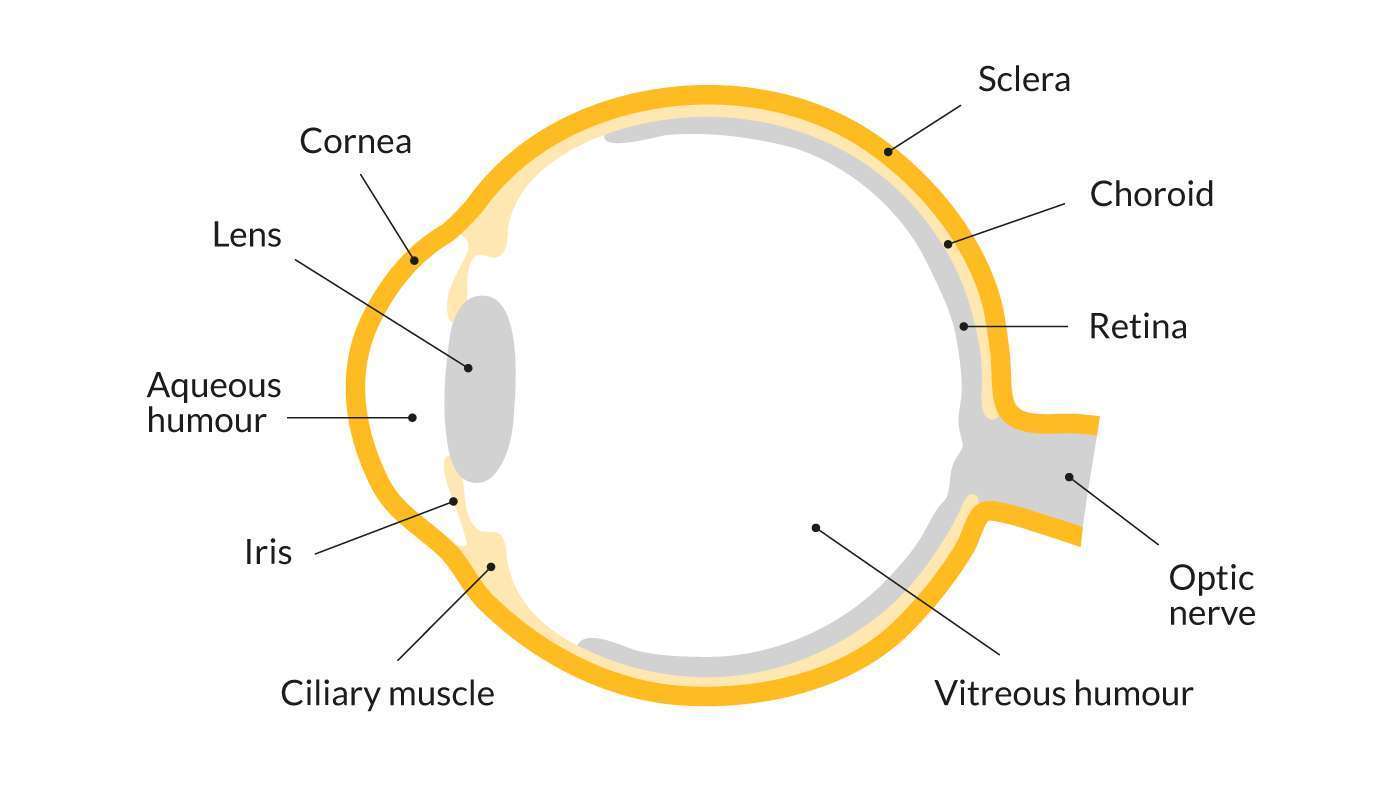The human eye is a complicated organ answerable for vision.
Its shape consists of numerous key components:
Cornea:
The cornea is the transparent, outermost part of the eye. It helps in focusing light into the eye.
Sclera:
The sclera is the white, tough, outer layer of the eye that helps maintain the shape of the eye.
Iris:
The colored part of the eye, the iris, controls the size of the pupil, regulating the amount of light that enters the eye.
Pupil:
The pupil is the black center of the eye, and its size changes in response to light levels.
Lens:
The lens is a flexible, transparent structure that helps to focus light onto the retina. It can change shape to adjust the focus for objects at different distances.
Retina:
The retina is the innermost layer of the eye, containing light-sensitive cells called photoreceptors. These cells, known as rods and cones, detect light and send signals to the brain through the optic nerve.
Macula:
The macula is a small, specialized area in the center of the retina responsible for detailed central vision.
Optic Nerve:
The optic nerve is a package of nerve fibers that contains visible statistics from the retina to the brain.
Vitreous Humor:
The vitreous humor is a clear, gel-like substance that fills the space between the lens and the retina, helping to maintain the eye’s shape.
Aqueous Humor:
The aqueous humor is a clear fluid that fills the front part of the eye, maintaining pressure and providing nutrients to the cornea and lens.
Ciliary Body:
The ciliary body is a ring-shaped structure that contains muscles and helps control the shape of the lens, contributing to the eye’s ability to focus on objects at different distances.
These structures work together to capture and process visual information, enabling humans to see the surrounding world. The brain interprets the signals sent by the eyes, allowing us to perceive shapes, colors, and objects.
Here are some common eye disorders:
Refractive Errors:
Myopia (Nearsightedness): Difficulty seeing distant objects clearly.
Hyperopia (Farsightedness): Difficulty seeing close objects clearly.
Astigmatism: Blurred or distorted imaginative and prescient because of abnormal form of the cornea or lens.
Age-Related Macular Degeneration (AMD):
A condition that affects the macula, causing a gradual loss of central vision.
Cataracts:
Clouding of the eye’s natural lens, leading to blurry or hazy vision.
Glaucoma:
Increased intraocular stress which can harm the optic nerve and result in imaginative and prescient loss.
Diabetic Retinopathy:
Damage to the blood vessels of the retina due to diabetes, potentially causing vision loss.
Retinal Detachment:
The retina separates from the underlying layers of the eye, leading to vision loss.
Conjunctivitis (Pink Eye):
Inflammation of the conjunctiva, the thin membrane covering the white part of the eye.
Strabismus:
Misalignment of the eyes, causing crossed or turned eyes.
Amblyopia (Lazy Eye):
Reduced vision in one eye due to poor visual development during childhood.
Dry Eye Syndrome:
Insufficient production of tears or poor-quality tears, leading to discomfort and vision problems.
Keratitis:
Inflammation of the cornea, regularly because of contamination or injury.
Retinitis Pigmentosa:
A group of genetic disorders leading to the breakdown and loss of cells in the retina.
Color Blindness:
Difficulty distinguishing between certain colors, usually red and green.
Uveitis:
Inflammation of the uvea, the middle layer of the eye, which includes the iris, ciliary body, and choroid.
Ptosis:
Drooping of the upper eyelid, which can affect vision if severe.
It’s essential to consult with an eye care professional if you experience any changes in your vision or eye health. Early detection and appropriate treatment can often prevent or minimize the impact of many eye disorders.
Here are some tips to help protect your eyes and reduce the risk of eye disorders:
Regular Eye Exams:
Schedule everyday eye assessments with a watch care professional. These exams can help detect potential issues early on.
Healthy Diet:
Eat a balanced diet rich in fruits, vegetables, and omega-3 fatty acids. Nutrients like vitamins A, C, and E, as well as zinc, are important for eye health.
Stay Hydrated:
Drink plenty of water to keep your body and eyes hydrated.
Protective Eyewear:
Wear sunglasses that block ultraviolet (UV) rays to protect your eyes from harmful sun exposure.
If you work in environments with potential eye hazards, wear appropriate safety glasses or goggles.
Limit Screen Time:
Follow the 20-20-20 rule when using digital devices: every 20 minutes, look at something 20 feet away for at least 20 seconds to reduce eye strain.
Adjust screen brightness, contrast, and font size to make it easier on your eyes.
Proper Lighting:
Ensure good lighting when reading or working. Avoid glare and position lights to reduce shadows.
Eye Exercises:
Practice eye exercises to improve focus, reduce eye strain, and maintain flexibility.
Adequate Sleep:
Get enough sleep to allow your eyes to rest and recover.
Quit Smoking:
If you smoke, consider quitting. Smoking is linked to an increased risk of several eye disorders.
Manage Health Conditions:
Control conditions like diabetes and hypertension, as they can affect eye health.
Hygiene Practices:
Wash your hands regularly to prevent the spread of infections.Avoid touching your eyes with grimy hands.
Use Lubricating Eye Drops:
If you experience dry eyes, consider using artificial tears or lubricating eye drops as recommended by your eye care professional.
Be Aware of Family History:
Know your family’s eye health history, as some eye conditions have a genetic component.
Maintain a Healthy Weight:
Obesity is linked to an increased risk of diabetes and other conditions that can affect eye health.
Follow Doctor’s Advice:
If you are prescribed corrective lenses or medications, use them as directed by your eye care professional.
It’s important to note that while these tips can contribute to maintaining good eye health, individual needs may vary. Regular check-ups with an eye care professional are crucial for personalized advice and early detection of potential issues. If you experience any changes in your vision or eye health, consult an eye care professional promptly.
Internal link : emitsnews




